Secure Encapsulation Schemes Using Key Recovery System in IoMT Environments
Abstract
1. Introduction
- It provided a key recovery system based on secure encapsulation against various types of attacks and provides the ability to securely recover a lost or corrupted key.
- It uses signcryption to ensure KRF integrity and non-repudiation. In addition, it provides both digital signing and encryption at the same time to increase computational efficiency.
- It uses values that only authorized KRAs hold to prevent unauthorized KRAs and group-based authentication attacks. If some KRAs do not perform the key recovery properly, key recovery may be performed by other authenticated KRAs to prevent a single point of failure.
- It prevents the Med, KRC, and KRA from behaving maliciously to recover keys without authorization and prevents unauthorized entities from obtaining keys.
- It uses a partial private key generation scheme to prevent the KGC from generating private keys for all participants.
2. Related Work
2.1. Encapsulation Key Recovery Systems
2.2. Multi-Agent Key Recovery
2.3. Signcryption
2.4. Secret Sharing
2.5. Proxy Re-Encryption
3. System Model
3.1. Common Proposed Key Recovery System Model
3.1.1. Common Design Goals of Proposed Schemes
3.1.2. Common Objects of Proposed Schemes
- Key Generation Center (): Every participant must perform the and key generation and communication steps to generate keys. All can generate a private key through the private key generation step with , and a public key corresponding to the private key can be generated. The publishes the public parameter for performing encrypted communication with .
- Devices (): are medical devices and monitoring devices. Devices perform communication in the system managed by the . In this model, s must perform communication in the format designated by , and the basic format follows the form of , in which the ciphertext and are concatenated. Devices participating in the communication need ’s public parameters in order to make the session key used for message encryption into . Furthermore, the generated should be designed to only be controlled by and .
- Medical Institution (): is a medical institution that manages device authorization control and data on medical devices. When a device requests key recovery, the verifies that it is the lawful owner of the . In this paper, the step of confirming whether the is a lawful owner is omitted. In addition, the sends the to to help recover the key.
3.2. Proposed Scheme-I(Key Recovery System Using Signcryption)
3.2.1. Design Goals of Proposed Scheme-I
3.2.2. Objects of Proposed Scheme-I
- Participants: represents all participants (-) who use the encrypted communication provided by . can perform encrypted communication only by using provided by .
- Key Recovery Center (): is an organization in charge of key recovery and plays a central role in key recovery. The key recovery process is performed according to ’s request for key recovery, and is converted into a form that can be recovered using ’s private key. In this model, to reduce the burden of ’s key recovery operation, the help of M- is needed.
- Multi-Key Recovery Agents (M-): M- is the agent that helps some operations of key recovery by reducing the burden on . The included in the M- determines whether the is suitable for recovery to prevent abuse of the ’s authority. When receiving a key recovery request from , M- perform the recovery process using their private key. Furthermore, M- send the obtained session key pieces to .
3.2.3. Security Requirements of Proposed Scheme-I
- KRF integrity: No participant in key recovery can maliciously transform information from the device and information required for key recovery cannot be changed.
- Data confidentiality: It should be possible for only authorized devices to decrypt encrypted data.
- Non-repudiation: The device should not be able to reject the fact that it generated the . In addition, the fact that device-generated should be clear after transmission, exchange, communication, and processing.
- Attack on group authentication detection: If a malicious third-party pretends to be a lawful member of the key recovery group, should be detected through group verification.
- Single point of failure protection: In M-, some s should be able to recover session keys even if another fails to operate properly.
3.3. Proposed Scheme-II (Key Recovery System Using Proxy Re-Encryption)
3.3.1. Design Goals of Proposed Scheme-II
3.3.2. Objects of Proposed Scheme-II
- Participants (): represents all participants () who use the encrypted communication provided by . can perform encrypted communication only by using provided by .
- Key Recovery Center (): is an organization in charge of key recovery and plays a central role in key recovery. The key recovery process is performed according to ’s request for key recovery, and is converted into a form that can be recovered using ’s public key. However, in this model, key recovery can only be completed with the help of to prevent abuse of privileges by .
- Key Recovery Auditor (): is a monitoring agency that judges whether a key can be recovered by auditing the validity of key recovery. The determines whether is suitable for recovery to prevent abuse of authority through collusion between the and the . If the key recovery request is deemed to be lawful, will perform the recovery process with its private key and sends it over to the .
3.3.3. Security Requirements of Proposed Scheme-II
- KRF integrity: No participant in key recovery can maliciously transform information from the device and information required for key recovery cannot be changed.
- Data confidentiality: It should be possible for only authorized devices to decrypt encrypted data.
- Med applied for support: The session key used for communication must be encrypted and stored in . In the event of an emergency when it is necessary to view the device’s data, the encrypted session key must be able to recover the encrypted message according to the procedure determined by as needed.
- Collusion attack resistance: Fewer than three participants among the , , and should not be allowed to obtain keys even if they are maliciously colluding.
- Key escrow problem: can generate private keys for all participants, but the complete private key must not be known.
4. Proposed Scheme-I (Key Recovery System Using Signcryption)
4.1. System Parameters
- p: Prime number
- q: Prime factor of p-1
- : Cyclic group on prime p
- g: Random generator,
- H: Hash function,
- : Master private key,
- : Master public key,
- : Monitoring devices
- : Medical devices
- : Network Participant i, ()
- : Random numbers,
- :’s private key,
- :’s public key,
- : Secret value of and ,
- : Partial session key of and
- : Session key between and
- x: Random number, with
- : Random number of ,
- : Group authentication values assigned to agents (Shared Group Number)
- : Signcryption values
- :ith signcryption pieces
- : Value containing the value to be recovered when some KRAs fail the key recovery operation
- :ith pieces
- : Message space,
- M: Plaintext message between and ()
- C: Ciphertext message (Encrypted M)
- : Key recovery field,
- :ith key recovery field piece,
4.2. Setup Phase
- Step 1: The KGC selects -bit large prime p, where q is a large prime factor of and group of prime order p. In addition, a random generator is selected.
- Step 2: A master private key is randomly selected and a master public key is computed.
- Step 3: KGC selects Hash function H.
- Step 4: Then, public parameters are published.
4.3. Key Pair Generation Phase
- Step 1: KGC generates parameters for participant through the following operation and sends them to through a secure channel.
- Step 2: Participant who receives from KGC, selects Random numbers and sets ’s private key .
- Step 3: Participant generates and sets public key .
4.4. Session Key Exchange and Encryption Phase
- Step 1: selects and calculate partial session key . also selects and calculates partial session key . After that, and exchange and with each other.
- Step 2: and calculate the session key using the exchanged values and .
- Step 3: generates random number and , which is then divided in half into and .
- Step 4: generates and s using and .
- Step 5: divides and s to and .where n is the number of KRA and .
4.5. KRF Generation Phase
- Step 1: requests to M-KRA.
- Step 2: Each of the KRAs requested for from randomly selects . After that, each KRA generates an by sharing generated through a secure channel with each other.
- Step 3: M-KRA send to .
- Step 4: generates using and . Then, is generated using , and .
- Step 5: generates using .
- Step 6: Then, the generated is attached to the ciphertext C.
4.6. KRA Fault Recovery Phase
- Step 1: refers to the total number of KRAs n and the number of KRAs required for key recovery as .
- Step 2: calculates the number of KRAs t required to distribute .
- Step 3: selects a KRA or KRAs to replace the failed as follows:
- Step 4: distributes to selected KRA or KRAs.
- Step 5: If fail to operate properly, the selected KRA or KRAs obtain and of failed KRA using the distributed and .
4.7. Session Key Recovery Phase
- Step 1: When requests decryption from Med to recover , and sends .
- Step 2: Then Med requests decryption from KRC to recover , and sends .
- Step 3: KRC upon receiving a request for decryption, obtains pieces after decrypt with .
- Step 4: The obtained pieces are sent to each M-KRA to request decryption.
- Step 5: The requested M-KRA obtain values with .
- Step 6: Among the obtained values, values are encrypted with and sends to the KRC.
- Step 7: KRC compares obtained by decrypting the received ciphertext with and . If they match, pieces are collected and are recovered.
- Step 8: KRC recovers the k value using the received ciphertext, public parameters, and recovered .
- Step 9: Then, KRC divides k by .
- Step 10: KRC recovers the using the obtained and c.
- Step 11: KRC compares the calculated and r values using the obtained .
- Step 12: If it matches, KRC sends the recovered to Med.
- Step 13: Then, Med sends to and the message is decrypted using the received .
5. Proposed Scheme-II (Key Recovery System Using Proxy Re-Encryption)
5.1. System Parameters
- q: Prime number
- : Hash functions,
- : Hash functions, for some bit-length
- : Hash functions,
- : Hash functions,
- : System participant i, ()
- s: Master secret key of KGC,
- :’s private key,
- :’s public key,
- : Key recovery field,
5.2. Setup Phase
- Step 1: selects -bit large prime q and group of prime order q. In addition, a random generator is selected.
- Step 2: randomly selects master secret key , and compute .
- Step 3: selects Hash function .
- Step 4: The message space and public parameters are published.
5.3. Key Pair Generation Phase
- Step 1: generates parameters for participant through the following operation and sends them to through a secure channel.
- Step 2: who receives from KGC, selects Random numbers and sets ’s private key .
- Step 3: generates and sets public key .After that, publishes public key .
5.4. Session Key Exchange and KRF Generation Phase
- Step 1: selects and calcultate partial session key .also selects and calculates partial session key .After that, and exchange and with each other.
- Step 2: and calculate the session key using the exchanged values and .
- Step 3: generates the ciphertext message using the generated session key .
- Step 4: After that, selects a random value and , and generates using and as follows:After that, and communicate with each other using .
5.5. Med Enforcement Phase
- Step 1: sends to to recover the session key .
- Step 2: generates the re-encryption key .
- Step 3: requests key recovery by sending the to the .
5.6. Session Key Recovery Phase
- Step 1: After receiving , calculates as using its as follows:After that, sends the generated to the .
- Step 2: After receiving , re-encrypts as using its as follows:After that, sends to the KRC.
- Step 3: re-decrypts to obtain using as follows:After that, sends to .
- Step 4: decrypts to obtain as follows:After that, sends to .
- Step 5: decrypts the message M using the obtained .
6. Analysis of the Proposed Schemes
6.1. Proposed Scheme-I (Key Recovery System Using Signcryption)
- KRF integrity: The device, , , and participating in key recovery should not be able to transform a device key that generates a maliciously. To solve this problem, this includes the session key hash in parameter r of the . Therefore, data cannot be forged. Only the device can access the session key generated by the device.
- Data confidentiality: In the proposed scheme-I, communication between devices is performed through a session key. Therefore, if the session key for the corresponding communication is unknown, the malicious user will not be able to obtain the message. In addition, as the generated in the communication process contains the public keys of and , third-party besides and cannot know the contents of the corresponding .
- Non-repudiation: If the device generates and uses the wrong , cannot recover the key. To solve this problem, the device should not be able to reject the fact that it generated . Therefore, this includes the private key of the device in parameter s of the . The device cannot deny that it generated the .
- Attack on group authentication detection: Malicious key recovery by third-party s should not be possible. Therefore, a lawful group member applies an XOR operation on the values from to to generate a shared group value of between groups. The device receives it from a lawful group member and hashes the to include in the . When recovers the complete key, it hashes and compares the sent by the with the contained in the to ensure it was received from a lawful .
- Single point of failure protection: As both the and all s participate in session key recovery, it should be possible to recover the key even if some s fail. Therefore, a special value is generated. If some s fail to recover the session key pieces, other s recover the session key pieces instead of the failed and send them to the . includes all pieces and the produced by the XOR operation. The other (not the corresponding ) decrypts and sends it to the , allowing the to recover the complete session key.
- Med applied for support: should be able to view the encrypted data by acquiring the encrypted session key in the event of an emergency where it is necessary to view the device’s data. Therefore, sends to , and decrypts to obtain pieces. The acquired pieces are sent to and requested for recovery. Then, obtains session key pieces by decrypting the acquired pieces. The obtained session key pieces are sent to , and recovers the complete session key. After that, it sends the complete session key to the , allowing message decryption.
- Key escrow problem: The proposed scheme-I is based on a CL-PKC scheme. Therefore, as can generate only a part of the private key during the private key generation process, the key escrow problem caused by in ID-based encryption has been solved.
6.2. Proposed Scheme-II (Key Recovery System Using Proxy Re-Encryption)
- KRF integrity: In this proposed scheme-II, is encrypted with the public keys of and . Therefore, during the key recovery process, , and cannot be forged or modified by alone.
- Data confidentiality: As the generated in the communication process contains the public key of the Med and the secret values of and , third-party besides the , , and cannot know the contents of the corresponding . In addition, even if all three of the , , and do not participate, each , , and cannot know the contents of the .
- Med applied for support: can perform recovery of as needed. is created using the public key of . can perform the key recovery process when it is determined that the key recovery is necessary for that it manages. For this, can create and request and execute the key recovery process through and .
- Collusion attack resistance: Fewer than three participants among the , , and must be prevented from maliciously acting together, thus preventing recovery of the key, and unauthorized entities must be prevented from obtaining the key. Therefore, the requires the cooperation of the and to decrypt . Thus, even if the has colluded with a single participant among the and , the completed key recovery cannot be achieved without the assistance of the third participant as follows:In order to obtain from the above , must be decrypted. In order to decrypt , and need to know c or . However, c and know only . Therefore, it is necessary to obtain by decrypting .Here, contains , so the attackers are and should be computed.Since can be created using a public key, anyone can create it. However, since only knows , attackers must use to calculate and .Here, a ’s private key is required to obtain from . Therefore, KRC is required in the key recovery process.Next, since the attacker does not know , he has to perform the following operation to calculate . In the end, the ’s private keys and are required, so is also required.Furthermore, an attacker who acquires must compute to obtain from .In order to acquire using , ’s private keys and are required, so is also required. As a result, in order to obtain by decrypting , all of , and must participate.
- Key escrow problem: The proposed scheme-II is based on a CL-PKC scheme. Therefore, as can generate only a part of the private key during the private key generation process, the key escrow problem caused by in ID-based encryption has been solved.
7. Conclusions
Author Contributions
Funding
Conflicts of Interest
References
- Qiu, T.; Chen, N.; Li, K.; Atiquzzaman, M.; Zhao, W. How can heterogeneous internet of things build our future: A survey. IEEE Commun. Surv. Tutor. 2018, 20, 2011–2027. [Google Scholar] [CrossRef]
- Shammar, E.A.; Zahary, A.T. The Internet of Things (IoT): A survey of techniques, operating systems, and trends. Library Hi Tech 2019, 38, 5–66. [Google Scholar] [CrossRef]
- Yu, J.Y.; Kim, Y.G. Analysis of IoT platform security: A survey. In Proceedings of the 2019 International Conference on Platform Technology and Service (PlatCon), Jeju, Korea, 28–30 January 2019; pp. 1–5. [Google Scholar]
- Standard, D.E. Federal Information Processing Standards Publication 46; National Bureau of Standards; US Department of Commerce: Washington, DC, USA, 1977; Volume 23. [Google Scholar]
- Denning, D.E.; Branstad, D.K. A taxonomy for key escrow encryption systems. Commun. ACM 1996, 39, 34–40. [Google Scholar] [CrossRef]
- Guo, H.; Zheng, Y.; Li, X.; Li, Z.; Xia, C. Self-healing group key distribution protocol in wireless sensor networks for secure IoT communications. Future Gener. Comput. Syst. 2018, 89, 713–721. [Google Scholar] [CrossRef]
- Lee, Y.; Park, Y.; Kim, C.S.; Lee, B. Threats Analysis and Mobile Key Recovery for Internet of Things. J. Korea Multimed. Soc. 2016, 19, 918–923. [Google Scholar] [CrossRef][Green Version]
- Sung, S.H. Key Management for Secure Internet of Things (IoT) Data in Cloud Computing. J. Korea Inst. Inf. Secur. Cryptol. 2017, 27, 353–360. [Google Scholar]
- Hatzivasilis, G.; Soultatos, O.; Ioannidis, S.; Verikoukis, C.; Demetriou, G.; Tsatsoulis, C. Review of security and privacy for the Internet of Medical Things (IoMT). In Proceedings of the 2019 15th International Conference on Distributed Computing in Sensor Systems (DCOSS), Santorini, Greece, 29–31 May 2019; pp. 457–464. [Google Scholar]
- Kanyamee, K.; Sathitwiriyawong, C. High-availability decentralized cryptographic multi-agent key recovery. Int. Arab J. Inf. Technol. 2014, 11, 52–58. [Google Scholar]
- Lim, S.; Kang, S.; Sohn, J. Modeling of multiple agent based cryptographic key recovery protocol. In Proceedings of the IEEE 19th Annual Computer Security Applications Conference, Las Vegas, NV, USA, 8–12 December 2003; pp. 119–128. [Google Scholar]
- Han, K.; Yeun, C.Y.; Kim, K. New key escrow model for the lawful interception in 3GPP. In Proceedings of the IEEE 2009 Digest of Technical Papers International Conference on Consumer Electronics, Las Vegas, NV, USA, 10–14 January 2009; pp. 1–2. [Google Scholar]
- Huadpaknam, P.; Pirak, C.; Mathar, R. A Security Key Recovery System with Channel Quality Awareness for Smart Grid Applications. ECTI Trans. Comput. Inf. Technol. (ECTI-CIT) 2016, 10, 1–14. [Google Scholar]
- Gennaro, R.; Karger, P.; Matyas, S.; Peyravian, M.; Roginsky, A.; Safford, D.; Willett, M.; Zunic, N. Two-phase cryptographic key recovery system. Comput. Secur. 1997, 16, 481–506. [Google Scholar] [CrossRef]
- Zheng, Y. Digital signcryption or how to achieve cost (signature & encryption)≪ cost (signature)+ cost (encryption). In Proceedings of the Annual International Cryptology Conference, Santa Barbara, CA, USA, 17–21 August 1997; Springer: Berlin/Heidelberg, Germany, 1997; pp. 165–179. [Google Scholar]
- Liu, Z.; Hu, Y.; Zhang, X.; Ma, H. Certificateless signcryption scheme in the standard model. Inf. Sci. 2010, 180, 452–464. [Google Scholar] [CrossRef]
- Li, F.G.; Zhong, D. A Survey of Digital Signcryption. Netinfo Secur. 2011, 12, 1–8. [Google Scholar]
- Shamir, A. How to share a secret. Commun. ACM 1979, 22, 612–613. [Google Scholar] [CrossRef]
- Blakley, G.R. Safeguarding cryptographic keys. In Managing Requirements Knowledge, International Workshop on; IEEE Computer Society: New York, NY, USA, 1979; p. 313. [Google Scholar]
- Beimel, A. Secret-sharing schemes: A survey. In International Conference on Coding and Cryptology; Springer: Qingdao, China, 2011; pp. 11–46. [Google Scholar]
- Attasena, V.; Darmont, J.; Harbi, N. Secret sharing for cloud data security: A survey. VLDB J. 2017, 26, 657–681. [Google Scholar] [CrossRef]
- Blaze, M.; Bleumer, G.; Strauss, M. Divertible protocols and atomic proxy cryptography. In Proceedings of the International Conference on the Theory and Applications of Cryptographic Techniques, Espoo, Finland, 31 May–4 June 1998; Springer: Berlin/Heidelberg, Germany, 1998; pp. 127–144. [Google Scholar]
- ElGamal, T. A public key cryptosystem and a signature scheme based on discrete logarithms. IEEE Trans. Inf. Theory 1985, 31, 469–472. [Google Scholar] [CrossRef]
- Green, M.; Ateniese, G. Identity-based proxy re-encryption. In Proceedings of the International Conference on Applied Cryptography and Network Security, Zhuhai, China, 5–8 June 2007; Springer: Berlin/Heidelberg, Germany, 2007; pp. 288–306. [Google Scholar]
- Shamir, A. Identity-based cryptosystems and signature schemes. In Proceedings of the Workshop on the Theory and Application of Cryptographic Techniques, Santa Barbara, CA, USA, 19–22 August 1984; Springer: Berlin/Heidelberg, Germany, 1984; pp. 47–53. [Google Scholar]
- Al-Riyami, S.S.; Paterson, K.G. Certificateless public key cryptography. In Proceedings of the International Conference on the Theory and Application of Cryptology and Information Security, Taipei, Taiwan, 30 November–4 December 2003; Springer: Berlin/Heidelberg, Germany, 2003; pp. 452–473. [Google Scholar]
- Sur, C.; Jung, C.D.; Park, Y.; Rhee, K.H. Chosen-ciphertext secure certificateless proxy re-encryption. In Proceedings of the IFIP International Conference on Communications and Multimedia Security, Linz, Austria, 31 May–2 June 2010; Springer: Berlin/Heidelberg, Germany, 2010; pp. 214–232. [Google Scholar]
- Polyakov, Y.; Rohloff, K.; Sahu, G.; Vaikuntanathan, V. Fast proxy re-encryption for publish/subscribe systems. ACM Trans. Priv. Secur. (TOPS) 2017, 20, 1–31. [Google Scholar] [CrossRef]
- Dodis, Y.; Goldwasser, S.; Kalai, Y.T.; Peikert, C.; Vaikuntanathan, V. Public-key encryption schemes with auxiliary inputs. In Proceedings of the Theory of Cryptography Conference, Zurich, Switzerland, 9–11 February 2010; Springer: Berlin/Heidelberg, Germany, 2010; pp. 361–381. [Google Scholar]
- Mambo, M.; Okamoto, E. Proxy cryptosystems: Delegation of the power to decrypt ciphertexts. IEICE Trans. Fundam. Electron. Commun. Comput. Sci. 1997, 80, 54–63. [Google Scholar]
- Yang, K.; Xu, J.; Zhang, Z. Certificateless proxy re-encryption without pairings. In Proceedings of the International Conference on Information Security and Cryptology, Seoul, Korea, 27–29 November 2013; Springer: Cham, Switzerland, 2013; pp. 67–88. [Google Scholar]
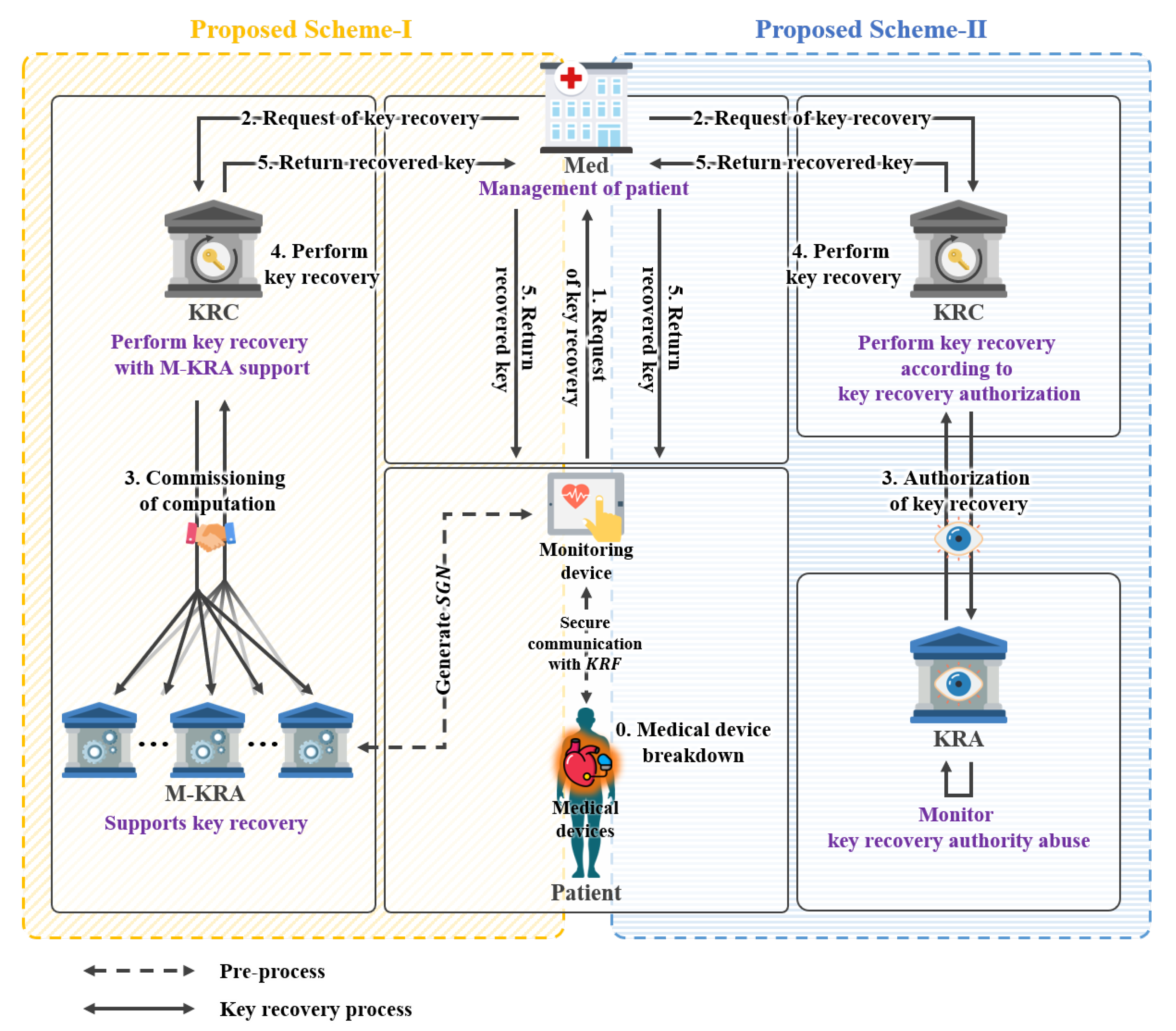
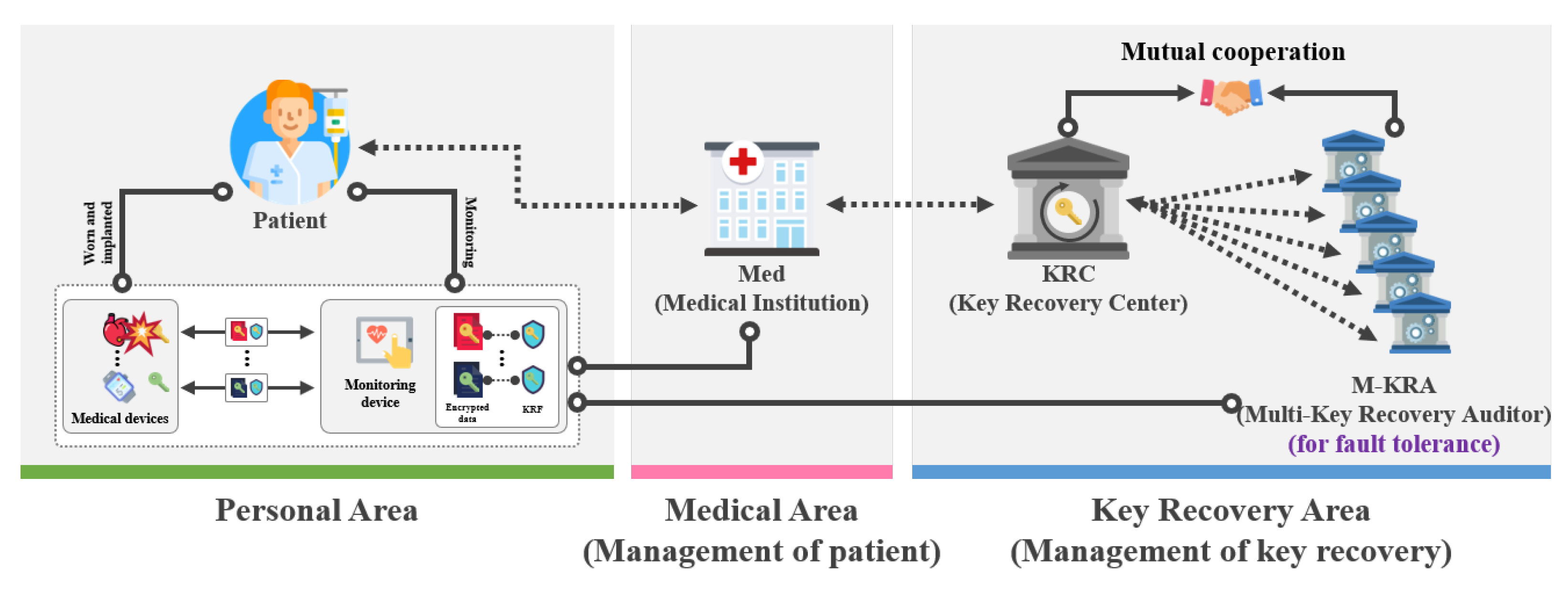
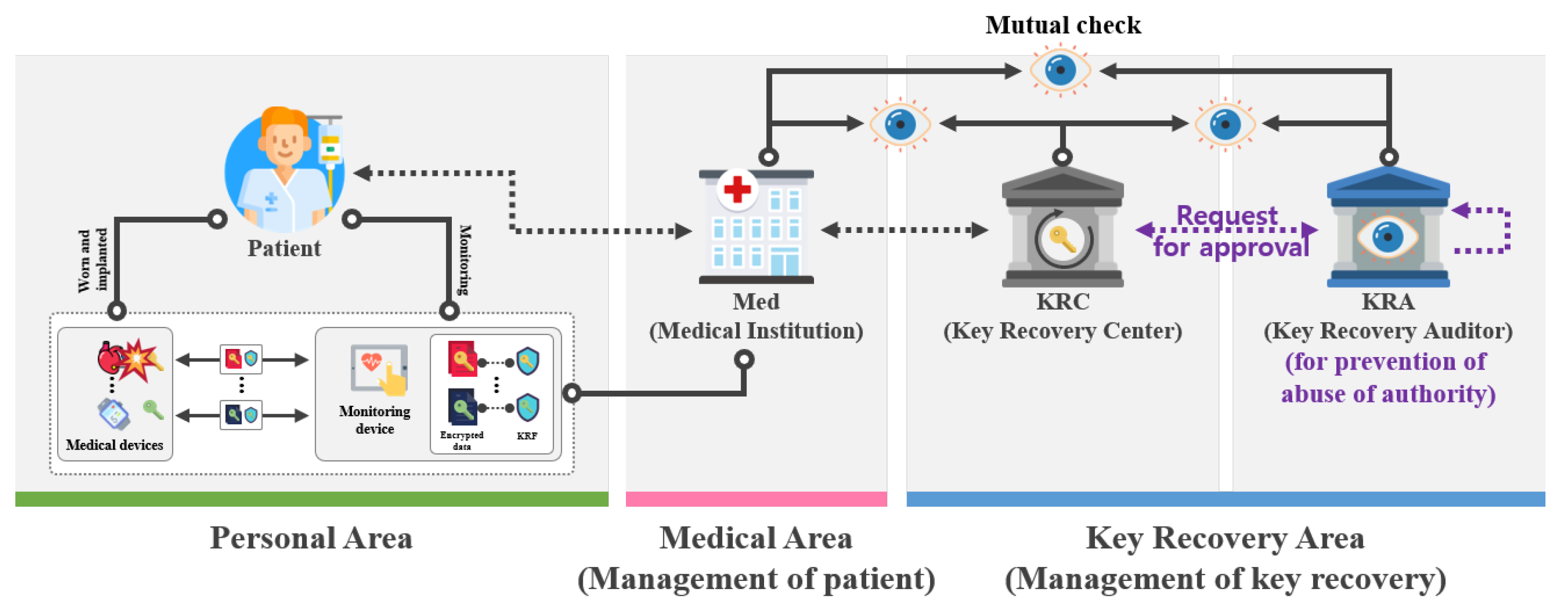

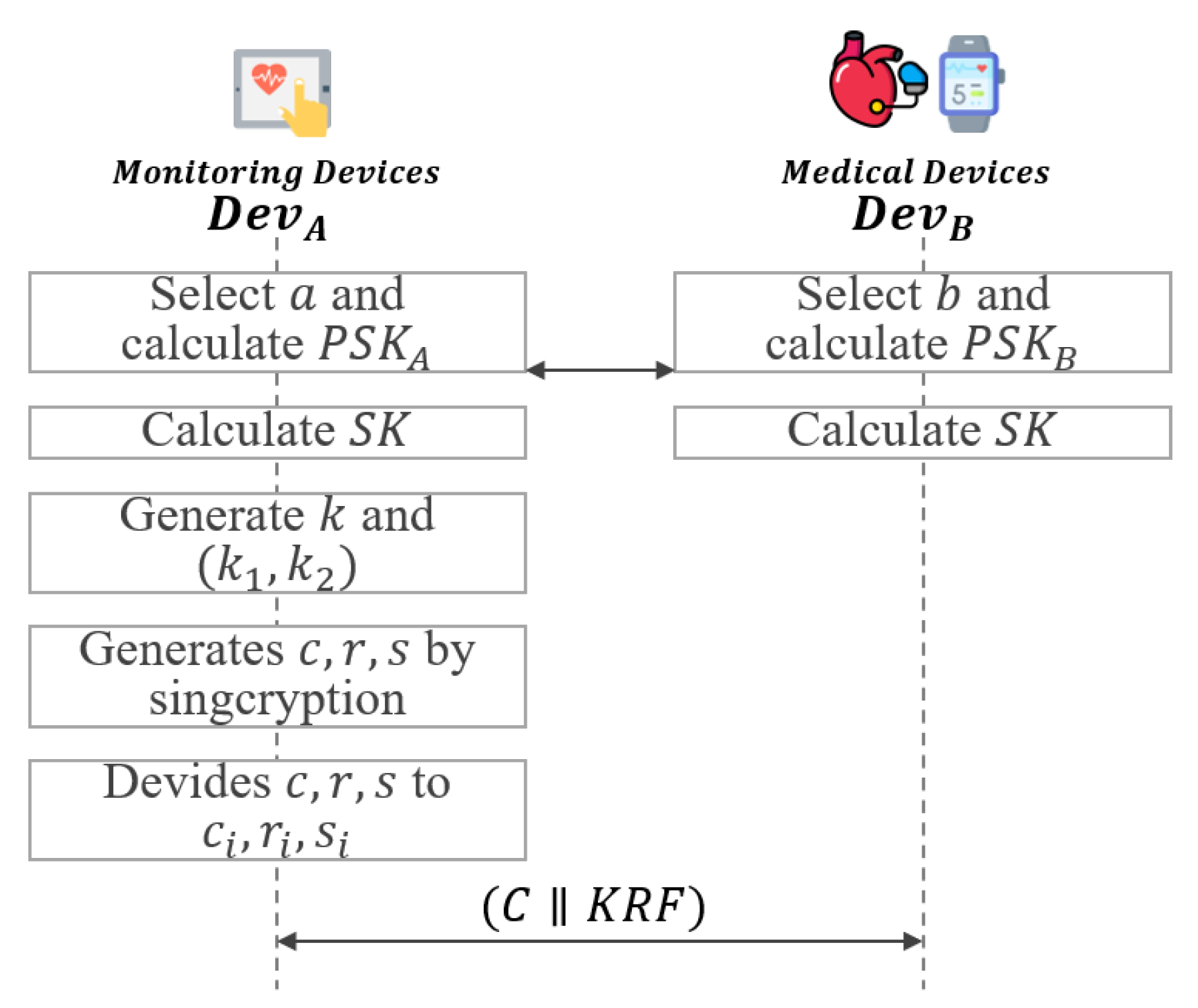
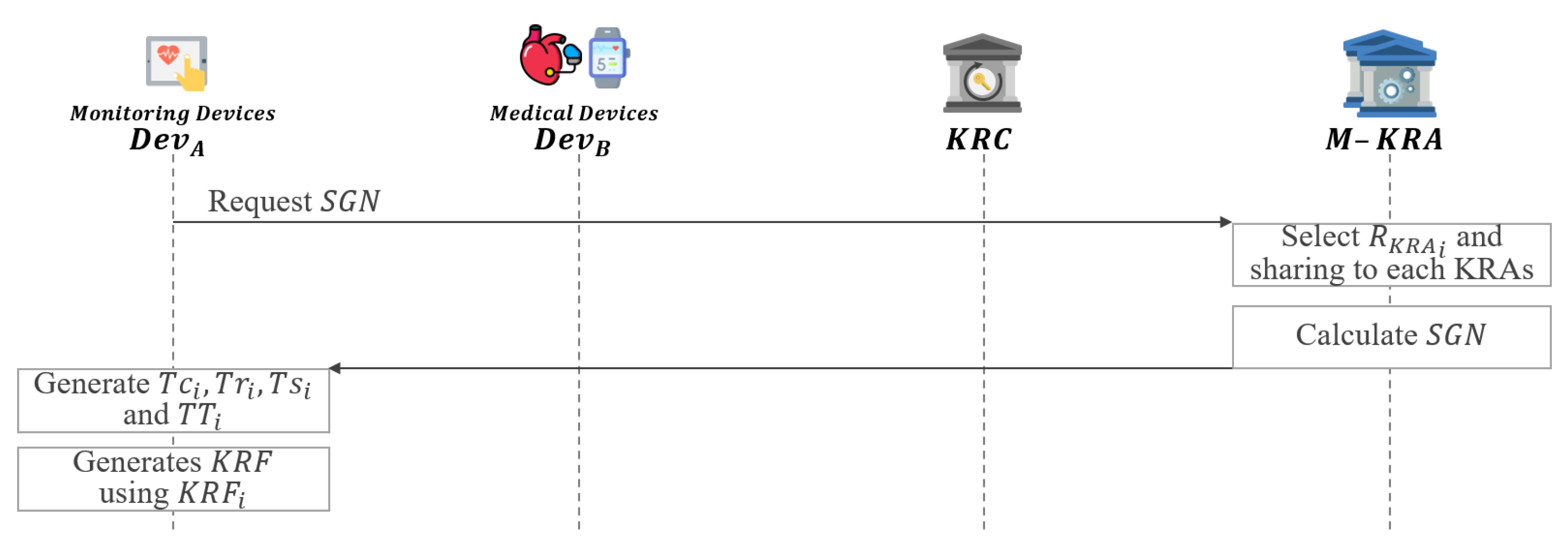

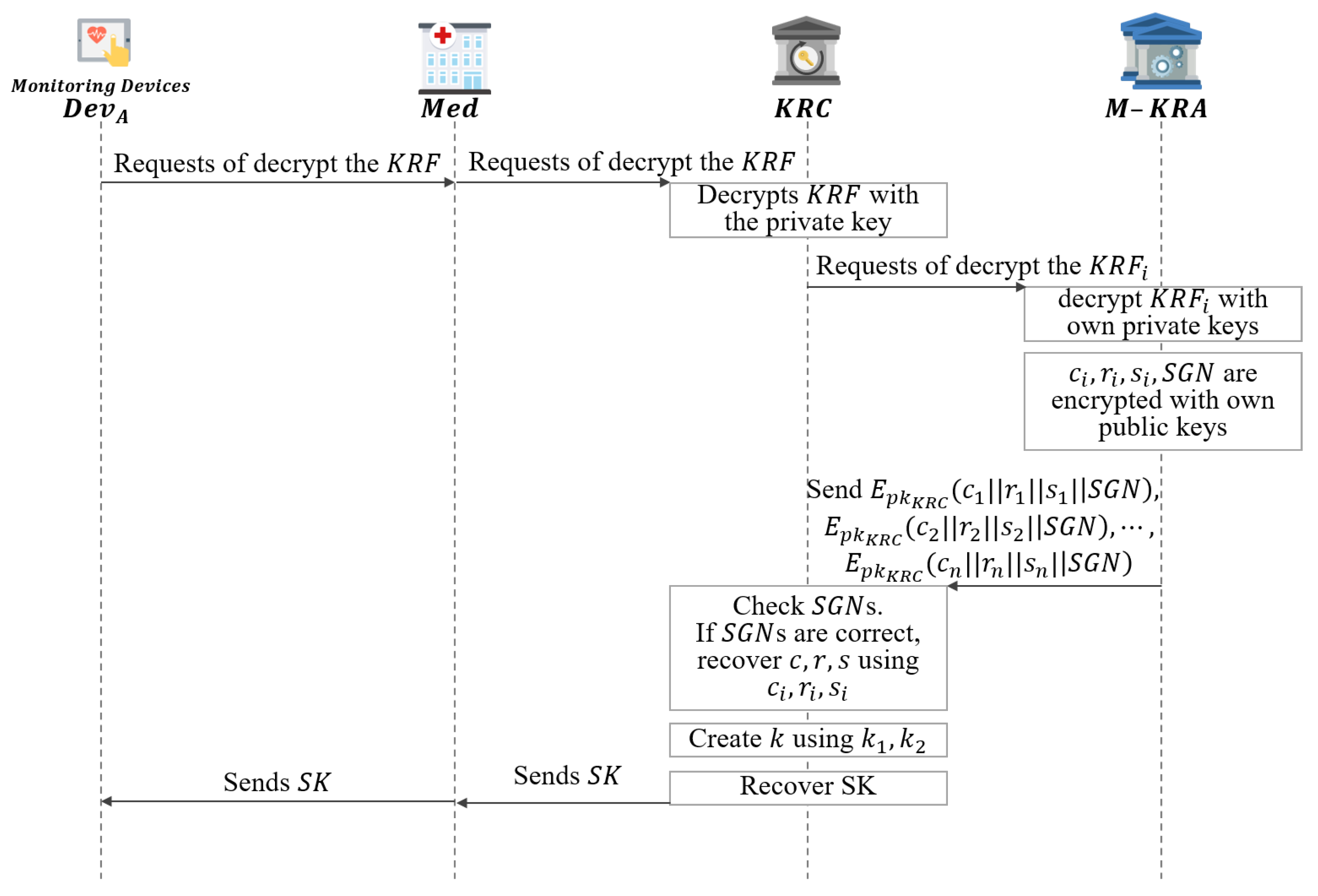

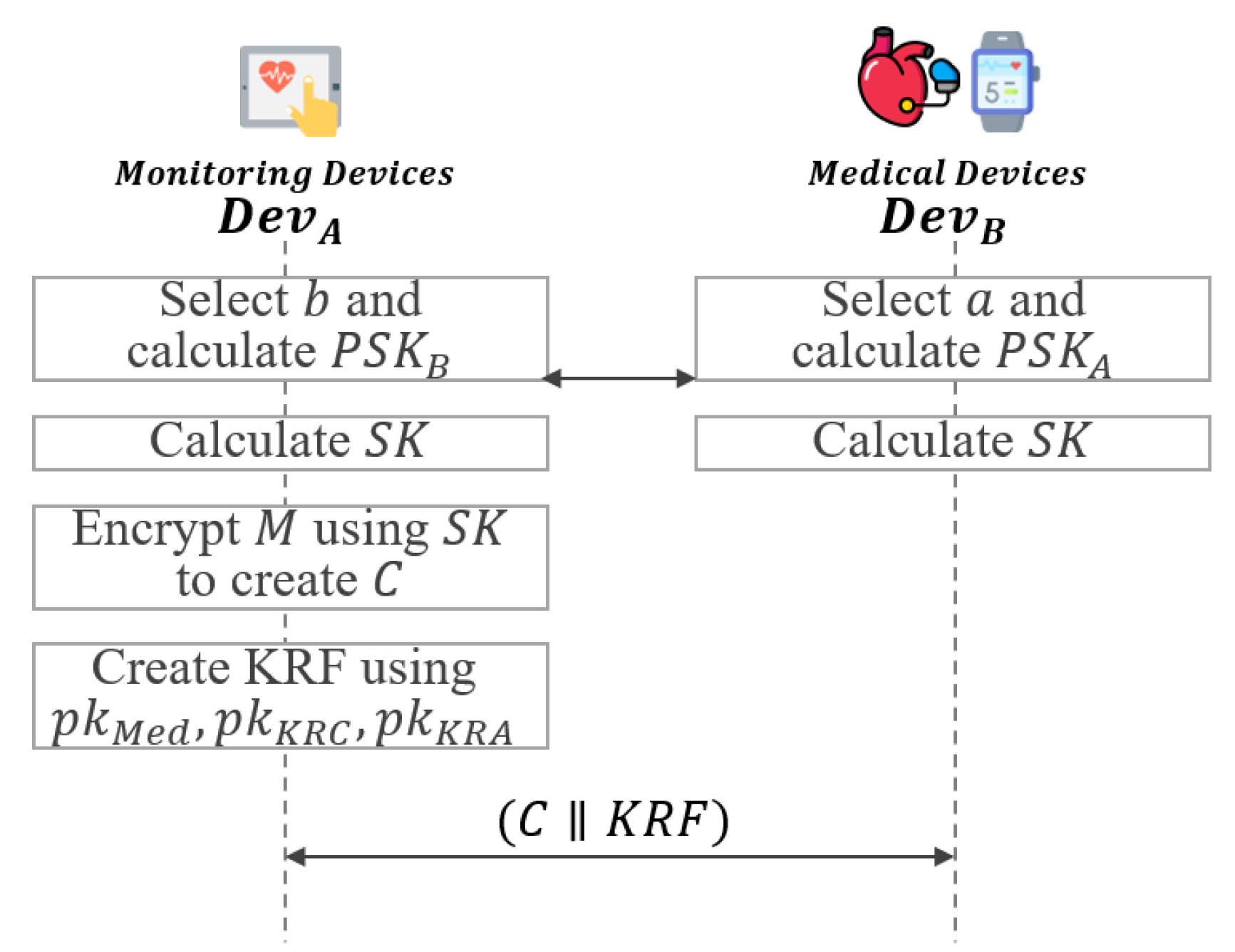
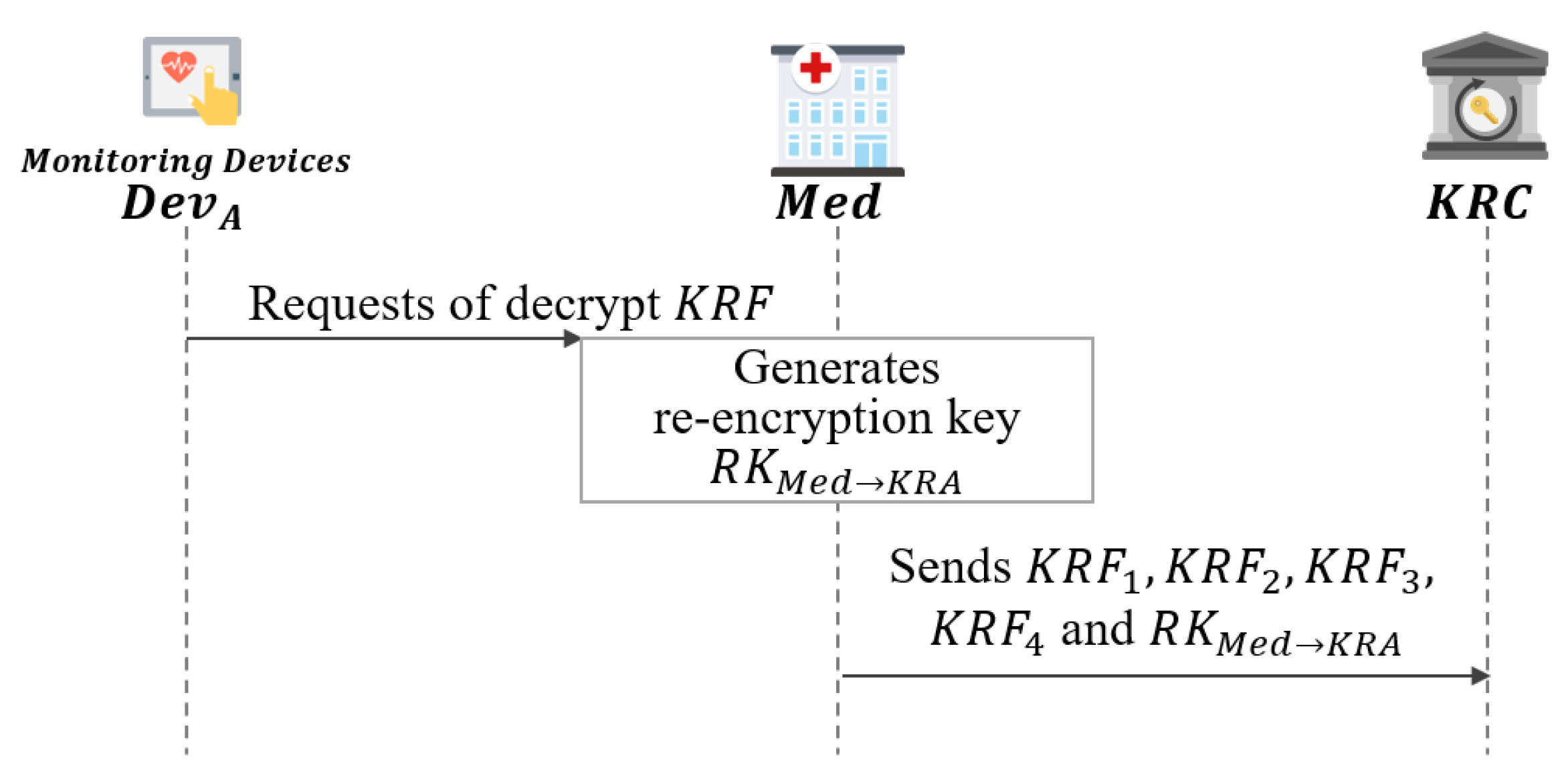
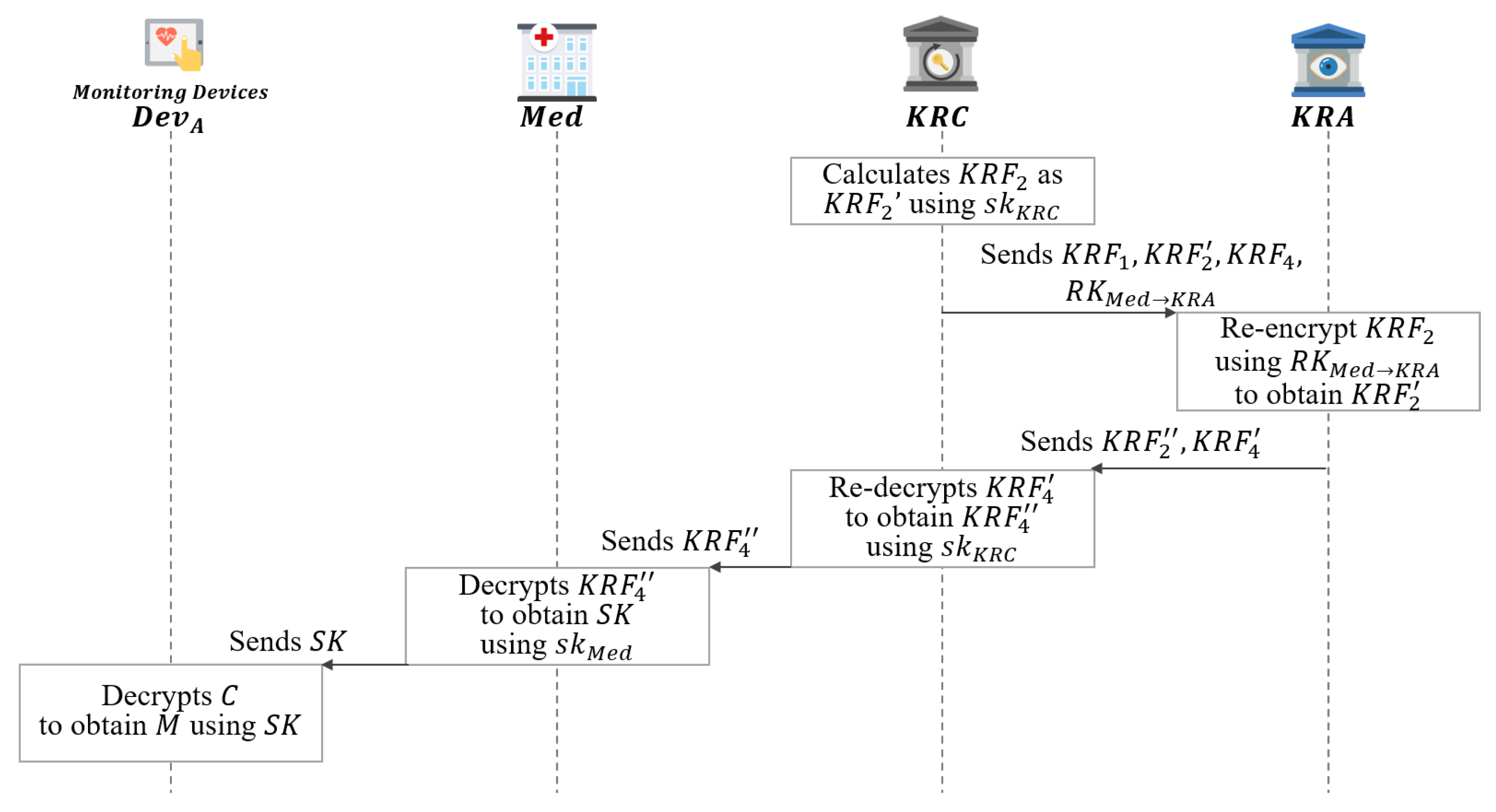
| [6] | [7] | [8] | [10] | [11] | [12] | [13] | Proposed Scheme-I | Proposed Scheme-II | |
|---|---|---|---|---|---|---|---|---|---|
| KRF integrity | - | - | - | × | × | × | × | ∨ | ∨ |
| Non-repudiation | - | - | - | × | × | × | × | ∨ | × |
| Attack on group authentication detection | - | ∨ | - | ∨ | × | × | ∨ | ∨ | - |
| Single point of failure protection | × | × | × | ∨ | ∨ | × | × | ∨ | × |
| Data confidentiality | ∨ | ∨ | ∨ | ∨ | ∨ | ∨ | ∨ | ∨ | ∨ |
| Med applied for support | - | - | - | - | - | - | - | ∨ | ∨ |
| Collusion attacks resistance | ∨ | × | × | × | × | × | × | × | ∨ |
| Key escrow problem | × | × | × | ∨ | × | × | × | ∨ | ∨ |
| ∨: Provided/×: Not provided/-:Not considered | |||||||||
Publisher’s Note: MDPI stays neutral with regard to jurisdictional claims in published maps and institutional affiliations. |
© 2021 by the authors. Licensee MDPI, Basel, Switzerland. This article is an open access article distributed under the terms and conditions of the Creative Commons Attribution (CC BY) license (https://creativecommons.org/licenses/by/4.0/).
Share and Cite
Kim, T.; Kim, W.; Seo, D.; Lee, I. Secure Encapsulation Schemes Using Key Recovery System in IoMT Environments. Sensors 2021, 21, 3474. https://doi.org/10.3390/s21103474
Kim T, Kim W, Seo D, Lee I. Secure Encapsulation Schemes Using Key Recovery System in IoMT Environments. Sensors. 2021; 21(10):3474. https://doi.org/10.3390/s21103474
Chicago/Turabian StyleKim, Taehoon, Wonbin Kim, Daehee Seo, and Imyeong Lee. 2021. "Secure Encapsulation Schemes Using Key Recovery System in IoMT Environments" Sensors 21, no. 10: 3474. https://doi.org/10.3390/s21103474
APA StyleKim, T., Kim, W., Seo, D., & Lee, I. (2021). Secure Encapsulation Schemes Using Key Recovery System in IoMT Environments. Sensors, 21(10), 3474. https://doi.org/10.3390/s21103474







